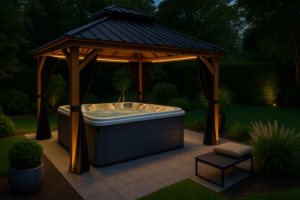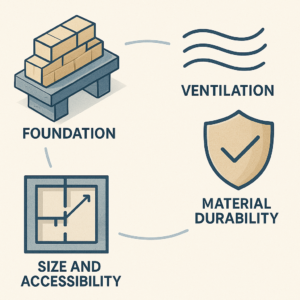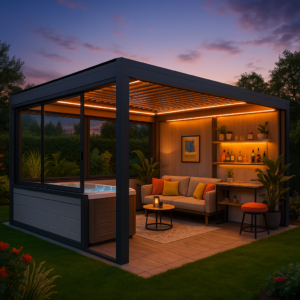Will a Gazebo Protect a Hot Tub? An In-Depth Expert Guide
Discover how a well-designed gazebo can shield your hot tub from the elements, enhance privacy, and boost your outdoor spa experience. This expert guide covers all you need to know—from the basic benefits and design choices to troubleshooting and long-term care.
Introduction
Imagine stepping into your backyard, where a cozy, stylish gazebo shelters your hot tub. This simple structure can do more than add beauty; it can protect your investment and keep your hot tub ready for use year-round. Did you know that proper shelter can extend your hot tub’s life and lower maintenance needs? In this guide, we explain how a gazebo works to protect your hot tub. You will learn the key benefits, design tips, and challenges you might face. We will explore the following:
- Main benefits: Weather protection, UV shielding, and privacy
- How to choose the right design: Materials, size, and ventilation
- Installation steps: What to do before and after setup
- Troubleshooting: How to solve common problems
- Long-term care and innovative uses: Ideas to enhance your setup
Our goal is to show you that a well-built gazebo can be a smart and stylish way to protect your hot tub. The information here is practical and easy to understand. Whether you are a hot tub beginner or looking to upgrade your outdoor space, this guide has something for you. Let’s dive into how a gazebo can offer full protection and add value to your home.

Main Topic Exploration
A gazebo is more than just a pretty cover for your hot tub. It acts as a shield against rain, snow, wind, and harsh sunlight. Let’s look at its key roles:
Weather Protection
A solid gazebo roof keeps water off your hot tub cover. This stops water from seeping in and changing the water’s balance. With proper drainage, rainwater and snow are channeled away, reducing the risk of damage.
- Rain and Snow: The waterproof roof stops water from diluting the hot tub’s chemicals.
- UV Rays: The shade helps prevent the hot tub’s shell from fading or cracking.
- Wind: Side panels and walls can block strong winds and prevent debris from blowing in.
Debris and Dust Control
Fallen leaves, dirt, and twigs can make hot tub care a hassle. A gazebo acts as a barrier. This means less cleaning and more time enjoying your hot tub.
Enhanced Privacy and Safety
Gazebos can be built with walls, curtains, or screens. This creates a private space where you can relax without being seen. It also keeps small animals and pests away from your hot tub.
Aesthetic and Functional Value
A gazebo transforms a simple hot tub into a backyard spa. It defines the space, adds style, and even provides spots to hang lights or speakers. You can add extra features like:
- Lighting: Soft LED lights for nighttime ambiance.
- Shelves or Hooks: For towels and spa accessories.
- Custom Panels: For adjustable privacy.
Ventilation and Maintenance
Good ventilation is vital. Hot tubs produce steam and moisture. Without proper airflow, mold and condensation can form. Designs with operable windows or vents help keep the air fresh. Choosing weather-resistant materials like aluminum or treated wood will also lower upkeep needs.
“A well-designed gazebo does more than just protect—it creates a personal retreat that you can enjoy every season.”
– Outdoor Living Expert
Below is a custom table that summarizes the core benefits of using a gazebo for hot tub protection:
Another table below compares common gazebo materials for hot tub protection:
The information here shows that while a gazebo can indeed protect your hot tub, its success depends on design, material, and proper installation.
Comparative Analysis
When choosing a gazebo for your hot tub, you must compare different options. Below is a side-by-side look at common types.
Comparison of Gazebo Types
| Type | Weather Protection | Ventilation | Aesthetic Appeal | Cost |
|---|---|---|---|---|
| Open-Sided | Moderate | High | High (Airy look) | $$ |
| Enclosed | High | Moderate | Customizable | $$$ |
| Retractable | High | High | Flexible design | $$$$ |
| Pergola-Style | Low to Moderate | High | Very attractive | $$ |
Pros and Cons Comparison
-
Open-Sided Gazebo:
Pros: Great airflow, lower cost.
Cons: Less protection from heavy rain or snow. -
Enclosed Gazebo:
Pros: Full protection against weather and debris.
Cons: May have ventilation issues if not well designed. -
Retractable Gazebo:
Pros: Adjusts to weather changes; offers both protection and open-air experience.
Cons: Higher cost and more complex to install. -
Pergola-Style Gazebo:
Pros: Attractive design and customizable with curtains.
Cons: Does not offer complete protection during heavy weather.
A clear recommendation is to choose based on your local climate and personal needs. If you face heavy rains or snow, an enclosed or retractable model is ideal. For a warm, dry area, an open-sided design might be best.
Performance Factors
Several factors affect how well a gazebo can protect your hot tub. Here’s what to consider:
Key Variables
- Structural Strength:
The gazebo must support the hot tub’s weight, even when filled with water. - Ventilation:
Good airflow prevents steam buildup and mold. - Material Durability:
Choose weather-resistant materials for long-term use. - Size and Layout:
Ensure there is enough space for safe access and maintenance.

Ranking Factors by Impact
- Structural Integrity: The most important factor, as it supports weight and safety.
- Ventilation: Critical to avoid moisture problems.
- Material Quality: Affects durability and maintenance.
- Size: Influences both usability and safety.
Below is a simple HTML diagram to show how these factors interact:
Actionable Strategies
- Optimize Structural Design: Work with experts to ensure the frame is strong.
- Ensure Proper Ventilation: Install vents or operable windows.
- Choose High-Quality Materials: Invest in long-lasting options like aluminum or treated wood.
- Plan Layout Carefully: Ensure your gazebo is spacious and well-placed in your yard.
These factors together ensure that your gazebo offers strong, reliable protection for your hot tub.
Implementation Guide
Ready to add a gazebo to protect your hot tub? Follow these step-by-step instructions:
-
Plan Your Space:
- Measure the area around your hot tub.
- Sketch a simple layout.
- Check local building codes and permit requirements.
-
Select Materials:
- Choose durable materials (aluminum, treated wood, or vinyl).
- Decide on a roof type (solid or retractable).
- Pick style features like privacy panels or curtains.
-
Design for Ventilation:
- Include roof vents or operable windows.
- Plan for open sides or screened panels to allow airflow.
-
Build a Stable Foundation:
- Use a concrete pad or properly laid pavers.
- Ensure the surface is level and strong enough for the weight.
-
Assemble the Gazebo:
- Follow manufacturer instructions or hire professionals.
- Secure the structure with heavy-duty anchors.
- Add extra support if you live in a windy or snowy area.
-
Install Accessories:
- Mount lighting fixtures, hooks, or shelves.
- Install any extra safety features like a locking gate.
-
Test and Adjust:
- Check that the structure is stable and that ventilation is adequate.
- Adjust panels or vents as needed to reduce condensation.
Expert Tip:
Ensure that all wiring and electrical work is done by a certified professional. This keeps your installation safe and code-compliant.
“Proper planning and quality installation are the keys to a long-lasting gazebo that protects your hot tub effectively.”
– Home Improvement Authority
Warnings:
- Do not ignore ventilation.
- Always check the weight limits and ensure proper anchoring.
Following these steps will help you create a safe, attractive, and functional gazebo that protects your hot tub for years to come.
Troubleshooting Section
Even with careful planning, problems may occur. Here are common issues and how to address them:
Common Problems and Solutions
-
Poor Ventilation:
- Symptom: Condensation or mold forming.
- Solution: Open windows or add vents. Clean any mold with safe cleaning products.
-
Structural Instability:
- Symptom: Swaying or uneven settling.
- Solution: Check the anchoring and foundation. Reinforce supports if needed.
-
Water Accumulation on Roof:
- Symptom: Puddles or leaks during rain.
- Solution: Ensure gutters and drainage channels are clear and well-installed.
-
Debris Build-Up:
- Symptom: Leaves or dust inside the gazebo.
- Solution: Regularly sweep and clean the area. Consider installing screens.
Diagnostic Approach
- Step 1: Inspect the entire structure for loose or damaged parts.
- Step 2: Check that all vents and windows function properly.
- Step 3: Test the stability by applying gentle pressure.
- Step 4: Clean the structure and monitor for recurring issues.
Pro Tip:
If you encounter repeated issues, consult a professional to check if design adjustments are needed.
Innovation and Extended Applications
A gazebo is not only for protection. It can be transformed into a multi-use outdoor feature:
Cutting-Edge Uses
-
Multi-Functional Outdoor Spa:
Transform your space with built-in sound systems, mood lighting, and even a mini bar. This creates a true spa experience. -
Smart Features:
Imagine a gazebo with automated windows and a retractable roof that adjusts to the weather. Some setups can be linked to smart home systems for real-time adjustments.

Emerging Trends
-
Eco-Friendly Materials:
New materials are being developed that are both sustainable and highly durable. They reduce maintenance and lower environmental impact. -
Modular Designs:
Modular gazebos allow you to expand or reconfigure your space as needed. This flexibility means you can adapt your outdoor area over time.
Creative Adaptations
-
Outdoor Offices or Studios:
Use the gazebo space for more than just a hot tub. Add seating and workspaces for a peaceful outdoor office. -
Year-Round Entertainment:
Incorporate a fire pit or outdoor heater to make the area usable even in cool weather. This turns your gazebo into a year-round entertainment zone.
Future Developments
Expect more smart features and energy-efficient designs. The trend is toward structures that adapt to changing weather and user needs with minimal effort.
Long-term Considerations
When planning for the future, think about sustainability and maintenance:
Sustainability and Maintenance
-
Durability:
Choose materials that last long with minimal upkeep. This saves money over time. -
Regular Upkeep:
Schedule annual inspections. Clean and seal wooden parts to prevent decay. -
Upgrades:
Watch for signs of wear. Replace or upgrade parts when necessary.
Cost-Benefit Analysis
-
Initial Investment:
A gazebo can be costly at first, but it protects your hot tub and reduces long-term repair expenses. -
Longevity:
With proper care, your gazebo can last many years and even add value to your home.
By planning for these long-term factors, you ensure that your outdoor spa remains a safe and attractive retreat for years to come.
Expert FAQ Section
Q1: Will a gazebo protect my hot tub from heavy snow?
A: Yes, a solid-roof gazebo with proper drainage can protect your hot tub from snow build-up. Make sure the structure is rated for high snow loads.
Q2: How does a gazebo improve ventilation around a hot tub?
A: Gazebos with operable windows and vents allow air to circulate, reducing moisture and preventing mold.
Q3: Can I add privacy screens to any gazebo design?
A: Most designs allow for added curtains or panels. Choose a model that supports custom features.
Q4: How much weight can a typical gazebo support?
A: It depends on the design and materials. A professional installation will ensure your gazebo supports the weight of a full hot tub safely.
Q5: What is the cost difference between open-sided and enclosed gazebos?
A: Open-sided models are usually less expensive, while enclosed or retractable models cost more due to additional materials and features.
Q6: Are there any special permits required?
A: Local building codes vary. Check with your local authority before installation.
Q7: How do I reduce the maintenance of a wooden gazebo?
A: Use weather-resistant sealants and stain it regularly. This helps protect against moisture and decay.
Conclusion
A gazebo can be a smart way to protect your hot tub. It shields your spa from rain, snow, wind, and harmful UV rays. It also keeps debris out and adds privacy to your outdoor space. When you choose the right design and materials, you extend the life of your hot tub while boosting your backyard’s charm.
By following proper planning, installation, and maintenance steps, you can create a safe, attractive space that you enjoy all year. This guide shows you that with a little care and smart choices, your gazebo will work hard to protect your hot tub. Now, take the next step and transform your outdoor space into a personal retreat that is both practical and stylish.
Additional Resources
- Home Depot – Outdoor Gazebos: Offers a range of options and installation tips.
- HGTV – Backyard Spa Ideas: Provides design inspiration and expert advice.
- Bob Vila – Building Outdoor Structures: Tips on planning and construction.
- This Old House – Maintenance Guides: Step-by-step maintenance advice.
- Angi – Professional Installation Services: Find experts near you.
Technical Glossary
Below are 10 key terms explained in simple language:
- Anchoring: The method used to secure a structure to the ground.
- Condensation: Water droplets that form when warm air meets a cool surface.
- Durability: The ability of a material to last without damage.
- Insulation: Material that keeps heat in or out to control temperature.
- Polycarbonate: A clear, strong plastic used in roofing.
- Retraction: The ability to move a cover or roof to open or close a space.
- Sealing: Applying a protective layer to prevent moisture damage.
- Structural Integrity: The overall strength and stability of a building.
- UV Rays: Sunlight that can damage materials over time.
- Ventilation: The process of moving air in and out of a space to reduce moisture.
Key Takeaways
- Protection: A gazebo shields your hot tub from weather, debris, and harmful UV rays.
- Design Matters: Choose the right material, ventilation, and size for optimal performance.
- Value: Enhanced privacy and aesthetics add value to your outdoor space.
- Maintenance: Regular upkeep and proper installation are key to long-term success.
- Customization: A variety of styles and features let you create your perfect outdoor retreat.
By following this expert guide, you are well on your way to creating a protected, stylish, and functional hot tub area. Enjoy your outdoor spa with peace of mind and a touch of luxury. Feel free to ask for further details or share your feedback on this guide!
